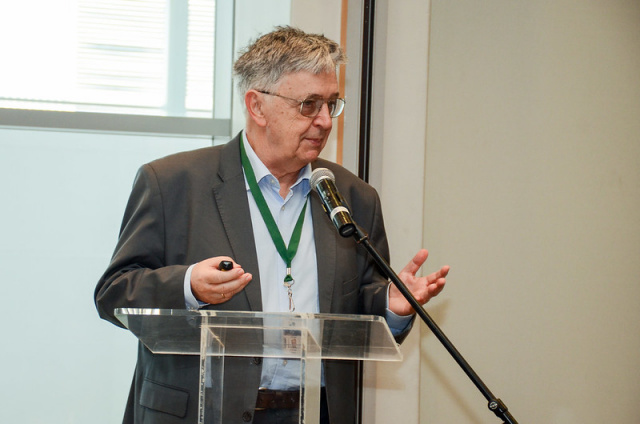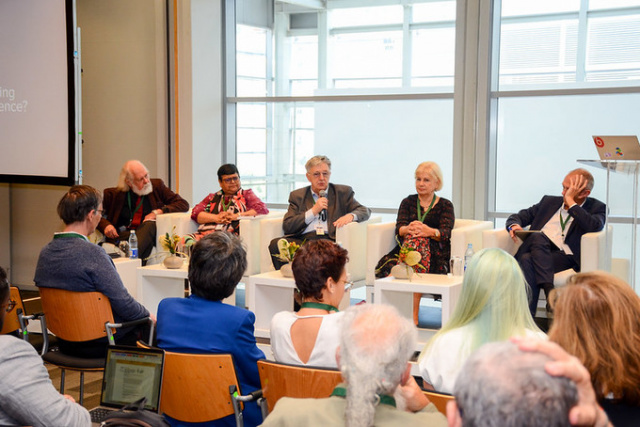Curiosity indeed remains the main driving force behind scientists’ achievements – a thematic session co-organized by MTA and ANSO as part of the World Science Forum 2022 was looking into the future of basic research
Do scientists still cherish that curiosity behind revolutionary ideas in science which has always spurred them on in their quest for the unknown? With today’s growing expectations over the accountability and the directly noticeable societal benefits of science funding, how can we reconcile these with the academic freedom that has always been so dear to the most outstanding figures of basic research?
In the thematic session moderated by Stephan Kuster (Frontiers), two prominent Hungarian scientists, the mathematician László Lovász and the plant biologist Éva Kondorosi were in attendance as MTA’s delegates, while Nils Christian Stenseth (University of Oslo) was representing the Alliance of International Science Organizations (ANSO) as its Science Ambassador. They were joined by Himla Soodyall, the Executive Officer of the Academy of Science of South Africa (ASSAf) and Antoine Petit, the Chairman and Chief Executive Officer of CNRS (the French National Research Centre).
The session had two parts: first, the panellists gave a short presentation of their own scientific background and an answer to the question raised in the title of the session. The second part was a panel discussion, where panellists could take questions from the moderator and from the audience.

About the element of unpredictability
In his lecture László Lovász was taking examples from mathematics – geometry, networks and number theory –, on a timescale ranging from antiquity to the present – , which clearly demonstrate the unpredictability which is inherent in the process of research at the time of the formulation of the initial research question/problem and that makes it hard to foresee the eventual scientific breakthrough, let alone the immediate overview of the practical implications and usefulness of an achievement in pure theoretics. The study of mazes led all the way to the function of GPS enabling us to find the shortest path to a specific location. An analysis of prime numbers laid the foundations for the science and techniques of cryptography. Elliptic curves had a role in the solution of Fermat’s Last Theorem, and this, in turn, led to the elaboration of elliptic curve cryptosystems. Or take for instance the Lenstra-Lenstra-Lovász algorithm, which was co-invented by László Lovász: it has lent itself to a great number of practical applications, among them the security check of various public-key cryptographic systems.
Oftentimes centuries go by before an achievement in theoretical science finds its way into practical usage,
and becomes so widely accessible as to bring meaningful benefits to the large public. It is quite frequently the case that people from all walks of life can enjoy the gifts of a scientific breakthrough without having any clue about its scientific background. All the functions of smartphones, the range of data protection services on the internet and a multitude of cutting-edge technological innovations are rooted in results of theoretical mathematics or, for that matter, in results of other fields of basic science.
Dichotomy in research
Professor of Ecology and Evolution at University of Oslo, as well as Science Ambassador of ANSO, Nils Christian Stenseth, started his lecture with a short introduction of ANSO. Boasting 67 members (organizations) from 48 countries, and founding members such as UNESCO, TWAS (The World Academy of Science) and also the Hungarian Academy of Sciences, ANSO has set itself as one of its chief missions to promote the advances of the United Nations’ Sustainable Development Goals („SDGs’, as they are called in UN jargon). Nils Stenseth devoted the second part of his lecture to the importance of basic science, and to the dichotomy between basic research and applied research. He, too, responded clearly in the affirmative to the query in the session title: researchers who do achieve breakthroughs are still driven by curiosity in their work. In Stenseth’s view, to contrast basic research with applied research does less good than harm: to justify his claim, he quoted Martin Rees, former president of the Royal Society London and Fredrick Barth, a Norwegian anthropologist. According to Rees, there is only “applied science and not yet applied science”, since all that is science necessarily ends up being applied sooner or later. In a similar vein, Barth says there is no point in distinguishing between “basic” and “applied” research, rather, there is “solid research which sooner or later will be applied, and lousy research which must never be applied”. Talking about the potential for basic science in Africa, Nils Stenseth argued for the expansion of curiosity-driven research opportunities and capacities in the African continent, as Africa’s extraordinary natural resources and biodiversity call for a local scientific community of excellent environmental scientists, biologists and experts in other fields of science who will be the best placed to contribute to the conservation of these values. With this purpose in mind, two associations, the African Research Universities Alliance and the Guild of European Research-Intensive Universities, have joined forces to demand greater investment by the African Union and the European Union in Africa’s universities, being fully aware that the close link between education and basic research cannot be ignored.
An intergrated approach to confront global challenges
Éva Kondorosi put the answer “yes” to the opening slide of her presentation, ruling out any doubt as to curiosity still being the main driving force in basic research. She then reflected on the start of Katalin Karikó’s scientific career, laden with hurdles, from the initial studies on the messenger RNA up to the development of the mRNA-based COVID-19 vaccine. Karikó’s perseverance finally bore fruit as her results, accumulated over decades of work, came to revolutionize the field of mRNA-based medicine at a moment in time when findings of theoretical medicine had to be put into practice with the utmost urgency in the midst of the ravages of the COVID-19 pandemic. Éva Kondorosi drew examples from her own career to illustrate how a field of science non-existent back in 1973 – in her case that of biological nitrogen fixation in Rhizobium-legume symbiosis – had paved the way for unexpected discoveries one after the other and finally raised the prospect of using the plant peptides produced in the symbiotic cells to develop new antibiotics. In the second part of her lecture, Éva Kondorosi talked about two major actors on the European science scene: the European Research Council (ERC), a leading funding entity for basic research in the EU, and the programme of the European Cooperation in Science & Technology (COST), also financed by the EU, which provides tools for fostering the ties of international collaboration between scientists doing basic research and innovators from all over the world. Currently, 70 so-called “COST actions” are running which involve African stakeholders from 11 countries. To wrap up, Professor Kondorosi stressed that if we want to tackle global challenges head-on, an integrated approach will be needed, for which
support for curiosity-driven research and safeguarding of academic freedom are key
and the international collaboration between researchers, as an effective tool in counteracting brain drain, holds great potential for generating added value.
 Éva Kondorosi Photo: MPI
Éva Kondorosi Photo: MPIAntoine Petit, heading the French national research centre, CNRS, explained in his lecture why he did not find it a good idea to set curiosity-driven research against the impact of science on society, and why he did not subscribe either to the concept whereby science and society, viewed as two distant points in space, opposing each other, should be served by a bridge that scientists are called upon to construct. Rather, he argued, science should be viewed as having its proper place within society, and not outside of it. We should work on strengthening this place of science in society. The scientific community as a whole is liable for transferring to the public the knowledge needed for it to be able to make conscientious choices and informed decisions. The tools for this are in the hands of scientists, they are the ones to make these easily accessible to society at large and explain what is at stake.
The last lecturer, Himla Soodyall, Executive Officer of the Academy of Science of South Africa (ASSAf), focused on the notion of curiosity taken from the session title and said it starts with kids: we are curious from the time we are able to think. We have an innate capacity for curiosity, for looking for the reasons behind things and trying to come up with responses. According to Soodyall, human solidarity and social justice are also driven by this curiosity. And when it comes to the very essence of science, the unknown is inherently there, since
we are searching for what is still not known and we may not foresee exactly what will be in store for us – should we know it already, it won’t be called research.
Just as all panellists before her, Soodyall also talked about her own scientific work, which had focused on the exploration of the genetic past of humankind. Through her study of population genetics, Himla Soodyall discovered in southern Africa what were presumably the most ancient human genetic lines.
 Photo: MPI
Photo: MPIThe five presentations were followed by a panel discussion. All panellists agreed in saying “yes” to the question raised in the title of the session. In reply to the moderator’s question as to whether curiosity-driven research may be viewed as a luxury reserved for the rich countries or whether it is something universal and essential, the panellists likewise agreed that it must be a universal necessity,
it must not be a privilege reserved for the rich countries. Small countries should definitely maintain their basic research capacities, since they cannot afford to limit themselves to applied research as basic research is the ground on which any innovation will be built.
The scientific community should also make sure that senior researchers take care of the young scientists through mentoring, based on strong ties between the two generation groups. Science may be enriched if it allows young researchers to come forward: the way questions are raised by youth is always radically different from the way they are asked by others. There was consensus also on the need for scientists to mingle much more with politicians and people to get their message across to them. At the same time, it must be accepted that political decisions will not necessarily be taken exclusively on scientific grounds.
In the wrap-up of the sessions, panellists called for the scientific community to stay open-minded towards blue-sky thinking, to listen to the views of scientists of different traditions or ages, and to encourage interconnections between the various fields of science to arrive at a truly integrated approach towards global challenges.
